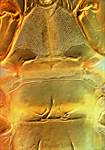
australis female

australis

australis antenna

australis metanotum, pelta & tergites

australis prosternites

australis antennal bases

australis male sternite VI
Generic diagnosis
Medium sized macropterous or micropterous Phlaeothripinae with sensillum on antennal segment II near base of segment. Head usually slightly longer than wide; postocular setae lateral in position; posterior ocelli in contact with compound eyes; mouth-cone short and rounded; maxillary stylets usually deeply retracted into head and about one fifth to one third of head width apart; maxillary bridge present. Antennae 8-segmented; segment II campaniform sensillum on basal half of segment; segment III with 2 sense cones, IV with 3 sense cones; segment VIII long and slender. Pronotum distinctly narrower than prothorax, surrounded by stippled membrane, only epimeral setae long; notopleural sutures complete. Prosternal basantra absent, but chitinous islets large; ferna wide apart; mesopresternum transverse but very slender; metathoracic sternopleural sutures short and broad. Fore tarsal tooth present in both sexes, usually stout and curved; mid- and hind tibiae each with one or two apical spur-like setae. Fore wing parallel-sided, with duplicated cilia. Pelta broad, with slender lateral lobes; tergite II eroded laterally; tergites II‒VII with wing-retaining setae weakly developed or absent; tergite IX setae S1 shorter than tube, S2 shorter and stouter in both sexes; tube relatively stout; both sexes have sternites V‒VIII usually with scale-like or worm-like reticulate areas. Male sternite VIII without pore plate.
Nomenclatural data
Plectrothrips Hood, 1908: 370. Type species Plectrothrips antennatus Hood, 1908, by monotypy.
There are 32 species known in this genus (ThripsWiki, 2022).
Australian species
Plectrothrips australis Okajima, 1981: 307
Relationship data
This genus is a typical member of the group known as Plectrothripini (Okajima 1981) in which adults have the second antennal segment bearing the campaniform sensillum on the basal half of this segment. This is in contrast to all other Phlaeothripidae in which this sensillum is on the apical half of the segment. Among the species involved, the pronotal sclerite is unusually narrow, and tergite II eroded laterally.
Distribution data
This genus is widespread around the world in tropical countries, and the only species recorded from Australia is closely related to one from Indonesia. It was described on specimens taken in quarantine at Boston, USA from "Australia", but was subsequently found in southeastern, central and north Queensland, also Northern Territory and on Norfolk Island.
Biological data
Members of this genus are usually found on dead branches, where presumably they are fungus-feeding.
References
Mound LA & Wells A (2015) Endemics and adventives: Thysanoptera (Insecta) Biodiversity of Norfolk, a tiny Pacific Island. Zootaxa 3964 (2): 183–210.
Okajima S (1981) A revision of the tribe Plectrothripini of fungus-feeding Thysanoptera (Phlaeothripidae: Phlaeothripinae). Systematic Entomology 6: 291–336.
ThripsWiki (2022) ThripsWiki - providing information on the World's thrips. Available from: http://thrips.info/wiki/ (Accessed 15.iii.2022)